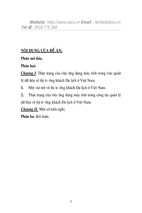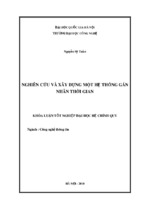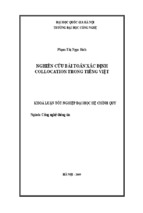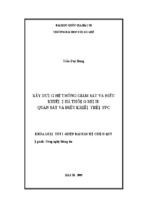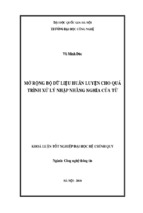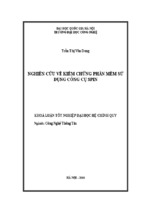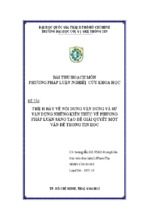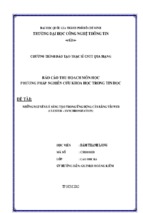Basics
6
How Spam is Sent
Tomasz Nidecki
Spammers often use poorly secured systems. The problems and costs resulting from sending of tens, or even
hundreds, of thousands of emails are carried to third
parties. We present the techniques which are being used
by spammers and teach you how to protect yourself from
them.
Editor-in-Chief: Piotr Sobolewski
Around hakin9
O
ur magazine is more than just eighty printed pages
enclosed in a colourful cover. Just take a look at our
website, forum, online store, hakin9.live... All this
just for you, our valued readers.
Our primary goal is to help you expand your knowledge.
And we are constantly trying to find new ways to reach this
goal. There is probably no need to mention that in both the
current and future issues of the hakin9 magazine you will
find valuable articles showing you secrets of IT security. But
there is more to it.
We are trying to help you make the decision, whether
the magazine is for you, by supplying various samples for
free. For every printed issue, one article is always available
for download in PDF format on our website. We have also
got a couple of articles from issues that never came out in
print in English – so you can see the direction hakin9 has
been taking in the past. Recently, we have started to publish
demos – first two pages of every printed article, also in PDF
format. They will be much more useful to you than simple
one-sentence summaries.
You can also buy hakin9 in PDF format, as single issues
or as a subscription. This is to make it more convenient for
readers from far away (we have got readers even in Malaysia
– greetings!). We are working on making all of the archives,
in all languages, also available in electronic format.
Whilst talking about expanding your knowledge, do
make sure to visit our online forum. It is meant as a means
for asking questions and getting answers from both us, the
editorial team, and other readers. We would also appreciate
if you used it as a means of sending us suggestions concerning the future direction of hakin9. Because, you must remember – hakin9 is for you. And you can help us make it better.
14
Usenet Abuse
Sławek Fydryk, Tomasz Nidecki
The standards and protocols used in Usenet are the
underlying technologies of the Internet. It is therefore
not surprising that, at the time when they emerged, no
one thought about security issues. But, as soon as the
Internet came into most households, it turned out that
the Usenet assumptions are, to say the least, leaky as
a sieve. Unfortunately, today, one cannot assume that
good manners will stop Internet users from deleting someone else's messages, removing groups or sending vulgar
swearwords to moderated discussion groups. We show
how easy it is to commit malicious acts on discussion
groups.
22
Attacks on Java 2 Micro Edition
Applications
Tomasz Rybicki
Java 2 Micro Edition, used mainly in portable devices,
is perceived as a generally safe programming environment. There exists, however, methods of attacking mobile
applications. They are based mainly on the mistakes
and carelessness of the programmers and distributors
of such applications. We will take a look at possible
scenarios of attack on mobile devices using this version
of Java.
Piotr Sobolewski
[email protected]
2
www.hakin9.org
hakin9 2/2005
Attack
Defence
32
Making a GNU/Linux Rootkit
48
SYSLOG Kernel Tunnel – Protecting
System Logs
Mariusz Burdach
Successfully compromising a system is only the beginning of
an intruders work. What can they gain from having access to
a superuser account if the administrator will notice right away
that the system's integrity has been compromised? The next
step of an intruder is to remove traces of their presence by
means of a rootkit, hopefully in such a way which will allow
them to use the victim's machine later on. Let us try to create
a simple rootkit for the Linux operating system which will be
responsible for hiding files, folders and processes having a
given prefix.
38
MD5 – Threats to a Popular Hash
Function
MD5 is probably the most popular hash function – its application ranges from simple file checksums up to DRM (Digital
Rights Management). Although, it appeared impossible to find
a hole in MD5, one has been found by Chinese scientists. Let
us take a look at what threats this hole could expose us to.
WARNING!
The techniques described in our articles may only be used in
private, local networks.
The editors hold no responsibility for misuse of the presented
is published by Software Wydawnictwo Sp. z o.o.
Editor-in-Chief: Piotr Sobolewski
[email protected]
Editor: Roman Polesek
[email protected]
Managing Editor: Tomasz Nidecki
[email protected]
Assistant Editor: Ewa Lipko
[email protected]
Production: Marta Kurpiewska
[email protected]
DTP: Anna Osiecka
[email protected]
Cover: Agnieszka Marchocka
Advertising department:
[email protected]
Subscription: Marzena Dmowska
[email protected]
Proofreaders: Nigel Bailey, Tomasz Nidecki
Translators: Michał Wojciechowski, Michał Swoboda, Radosław
Miszkiel, Jakub Konecki, Ewa Dacko
Postal address: Software–Wydawnictwo Sp. z o.o.,
ul. Lewartowskiego 6, 00-190 Warsaw, Poland
Tel: +48 22 860 18 81, Fax: +48 22 860 17 71
www.hakin9.org
Print: 101 Studio, Firma Tęgi
hakin9 2/2005
If an intruder takes control of our system logs we will not be
able to recreate their actions. The SYSLOG Kernel Tunnel
project supplies a mechanism which will send the logs in a
secure manner to a remote system and, at the same time, be
difficult to discover and kill.
58
Reverse Engineering – Dynamic
Analysis of Executable ELF Code
Marek Janiczek
Philipp Schwaha, Rene Heinzl
techniques or consequent data loss.
Michał Piotrowski
Dynamic analysis of code in the Executable and Linkable
Format (ELF) presents more possibilities than statical analysis. We will perform the analysis on a suspicious program
which was found on a compromised system. Apart from the
techniques and tools useful for the analysis, we present classic problems which can be encountered during tests.
72
Simple Methods for Exposing
Debuggers and the VMware
Environment
Mariusz Burdach
Analysis of ELF executable code can be complicated – programmers try to create applications in a way which would
render tracing of their programs impossible. The authors of
software also try to block the operation of their programs in
virtual environments. Let us take a look at how this is done.
For cooperation please email us at:
[email protected]
Whilst every effort has been made to ensure the high quality of the magazine, the
editors make no warranty, express or implied, concerning the results of content
usage.
All trade marks presented in the magazine were used only for informative
purposes. All rights to trade marks presented in the magazine are reserved by the
companies which own them.
To create graphs and diagrams we used
company.
programme by
The editors use automatic DTP system
ATTENTION!
Selling current or past issues of this magazine for prices that are different
than printed on the cover is – without permission of the publisher harmful
activity and will result in judicial liability.
hakin9 is available in: English, German, French, Spanish, Italian, Czech and
Polish.
www.hakin9.org
3
hakin9.live
•
•
•
CD Contents
•
T
he CD included with the magazine contains
hakin9.live (h9l) version 2.4 – a bootable Linux
distribution containing useful tools, documentation, tutorials and materials supplementing certain
articles.
In order to start working with hakin9.live one has to
boot the computer from the CD. Additional options regarding starting of the CD (language choice, different screen
resolution, disabling the framebuffer, etc.) are described
in the documentation on the CD – the index.html file.
What's new
We have changed the base system in the new issue. The
2.4 version of h9l is based on Aurox Live 10.1. The system
operates under the 2.6.7 kernel, hardware detection and
network configuration have been improved. Also, the
menu has become more seamless – all programs have
been divided into appropriate categories and therefore
access to any given application is much more intuitive.
However, the biggest change (one that you have been
asking for it for some time now) is the possibility to install
hakin9.live on your hard drive. The operation is very
simple – one just has to run the h9_install program on
a terminal (details can be found in the index.html file).
New programs are also present in the current version
of hakin9.live, amongst which are:
Figure 1. hakin9.live is a set of useful tools combined in
one place
4
Bandwidth Management Tools – a true all-in-one package for monitoring and managing Internet connections,
Wellenreiter – a graphical (GTK) wireless network
scanner/sniffer,
a bunch of addictive console games, useful when it is
time to relax,
a set of tools for reverse engineering in Linux.
At present, the default window manager is a slightly
modified fluxbox. It looks nice and has low requirements
– which is important for slower machines – and some say
it is more l33t. At the same time, it is possible to run the
friendly xfce4 graphical environment in its 4.2rc3 version.
Tutorials and documentation
The documentation, apart from instructions on how to run
and use hakin9.live, contains tutorials with useful practical
problems. The tutorials assume that we are using hakin9.live.
This way, we are removing the problems which were emerging due to different compiler versions, different configuration file locations or different options required for running
a program in a given environment.
In the current version of hakin9.live, apart from
the tutorials published in the previous issue, we have
attached two new ones. The first one informs us how to
carry out dynamic ELF analysis of a suspicious file by
means of reverse engineering. We will learn how to run
a program in a controlled manner and, step by step check
its malicious actions.
The second new tutorial is concerned with securing
system logs in Linux. The document describes a practical implementation of the SYSLOG Kernel Tunnel project
described in the article by Michał Piotrowski. n
Figure 2. New look, new menu
www.hakin9.org
hakin9 2/2005
How Spam is Sent
Tomasz Nidecki
Spammers often use
insufficiently secured systems.
The trouble and cost of sending
tens or hundreds of thousands
of messages are transferred to
third parties. You will learn what
techniques spammers use and
how to protect yourself.
Basics
S
6
ending a great number of emails
requires a lot of resources. A fast
connection and a dedicated server
are needed. Even if a spammer possesses
such resources, sending can take several
hours. Internet service providers are generally not happy when their networks are used
for spamming. The spammer can lose a connection before sending the majority of messages, and there are serious financial and
legal consequences waiting for spammers
who get caught.
Two basic methods are used by spammers to speed up sending. The first one is
based on minimalising the time required for
sending a message. It is known as fi re and
forget, meaning send and forget. The computer used for sending spam does not wait for
any response from the servers it is in contact
with.
The second method requires stealing resources from third parties, that either have
not properly secured their systems, or have
become the victims of a virus attack. The majority of costs, and often even the responsibility
of sending spam, is transferred to them, leaving
the spammer unpunished.
www.hakin9.org
SMTP protocol
Before learning methods used by spammers,
it is necessary to become familiar with the most
widely used protocol for sending electronic mail
– SMTP. It is based on, as most Internet protocols are, simple text commands.
Phases of sending mail
Electronic mail is sent in several phases
(see Figure 1). For a better understanding, let us suppose we want to send
an email from
[email protected] to
[email protected]. The user that sends
the message uses the Mozilla Thunderbird program in a local network; recipient
What you will learn...
•
•
•
•
how spammers send spam (using third party
computers),
how to protect your server from spammers,
how the SMTP protocol works,
what open relay, open proxy and zombie are.
What you should know...
•
how to use basic tools from the Linux system.
hakin9 2/2005
How spam is sent
Figure 1. Phases of sending mail
– the Outlook Express program and
a dial-up connection.
In the first phase, the Mozilla
Thunderbird program contacts the
SMTP server specified in the user
[email protected] mailbox settings
– mail.software.com.pl. The message
is sent to the server according to the
SMTP protocol. In the second phase,
mail.software.com.pl looks up entries
on DNS servers. It finds out that
mail.example.com is responsible for
receiving mail for the example.com
domain. This information is available
in the MX (Mail Exchanger) entry,
published by the DNS server, responsible for the example.com domain
(you can obtain it with the host or dig
program: host -t mx example.com or
dig example.com mx).
The History of SMTP
A precursor of SMTP was the SNDMSG (Send Message) program, used in 1971 by
Ray Tomlinson (in conjunction with his own project – CYPNET) to create an application
for sending electronic mail on the ARPANET network. One year later, a program used
on Arpanet for transferring files – FTP, was extended with MAIL and MLFL commands.
Mail was sent with FTP until 1980 – when the first electronic mail transfer protocol was
created – MTP (Mail Transfer Protocol), described in the RFC 772 document. MTP was
modified several times (RFC 780, 788), and in 1982, in RFC 821, Jonathan B. Postel
described Simple Mail Transfer Protocol.
SMTP, in its basic form, did not fulfil all expectations. There were many documents
created, describing its extensions. The most important are:
•
•
•
•
RFC 1123 – requirements for Internet servers (containing SMTP),
RFC 1425 – introduction of SMTP protocol extensions – ESMTP,
RFC 2505 – set of suggestions for server's anti-spam protection,
RFC 2554 – connection authorisation – introduction of the AUTH command,
An up-to-date SMTP standard was described in 2001 in RFC 2821. A full set of RFCs
can be found on our CD.
hakin9 2/2005
www.hakin9.org
In the third phase, mail.
software.com.pl connects to mail.
example.com and transfers the
message. In the fourth phase
– mail.example.com delivers the
received message to nobody user's local mailbox. In the fifth – the
nobody mailbox user connects to
the mail.example.com server via
a dial-up connection and POP3 (or
IMAP) protocol, and uses the Outlook Express program to download
the message.
The message actually takes
a slightly longer route. The sender
can use separate mail servers, i.e.
receive.software.com.pl and send.
software.com.pl. Then, the message will be received from users by
receive.software.com.pl, transferred
to send.software.com.pl, and sent to
mail.example.com. Similar situations
can happen with mail.example.com
– different servers may be responsible
for receiving and sending mail.
Programs that take part
in sending mail
There are several programs that take
part in sending mail:
7
�����������������������������
The Successor
of SMTP?
����������������
Dr. Dan Bernstein, the author of qmail,
created a protocol named QMTP
(Quick Mail Transfer Protocol) that
aims at replacing SMTP. It eliminates
many problems existing in SMTP, but
is incompatible with its predecessor.
Unfortunately, it is implemented in
qmail only.
More information about QMTP
is available at: http://cr.yp.to/proto/
qmtp.txt
�����
��������������������
������������
��������������������������
������������
�������������������������
���
�������������������������
����
����
���
����
•
��������������
����������������������
����������������������
�������������
��������������
���������������
�����������
�������������������
��������������������
��������������
�����������������
��������������������
•
������������
��������������������
������������������
�������������
�����������������������
����
•
�����������������������
������������
��
����������������������������
�����������������������
���������
�����
���
��������
�������
���
����
���
Basics
��������������������
������
������������
����������
Figure 2. Communication phases in SMTP
8
A program used by an end user
for receiving and sending mail,
and also for reading and writing
messages, known as an MUA
– Mail User Agent. Examples of
MUAs: Mozilla Thunderbird, Outlook Express, PINE, Mutt.
Part of a server responsible for
communication with users (mail
receiving) and transferring mail
to and from other servers, known
as an MTA – Mail Transfer Agent.
Most popular ones: Sendmail,
qmail, Postfix, Exim.
Part of a server responsible for
delivering mail to a local user,
known as an MDA – Mail Delivery
Agent. Examples of standalone
MDAs: Maildrop, Procmail. The
majority of MTAs have built-in
mechanisms for delivering mail
to local users, so there is often
no reason for using additional
MDAs.
Communication phases
in SMTP
Sending a message with the SMTP
protocol can be divided into several phases. Below, you can find
an example SMTP session between the mail.software.com.pl
and mail.example.com servers.
Data sent by mail.software.com.pl is
marked with the > sign, and data received from mail.example.com – with
the < sign.
After establishing a connection, mail.example.com introduces
itself:
< 220 mail.example.com ESMTP Program
www.hakin9.org
hakin9 2/2005
How spam is sent
informing us that its full host name
(FQDN) is mail.example.com. You
can also see that ESMTP (Extended
SMTP – see Table The most common SMTP protocol commands)
commands can be sent and that the
currently used MTA is Program. The
Program name is optional – some
MTAs, i.e. qmail, do not provide it.
You should introduce yourself:
> HELO mail.software.com.pl
Table 1. The most common SMTP protocol commands
Command
Description
HELO
Introduction to the server
EHLO
Introduction to the server with a request for the list of
available ESMTP commands
MAIL FROM:
Envelope sender address – in case of errors, the message will be returned to this address
RCPT TO:
Recipient address
DATA
Beginning of the body of the message
AUTH
Connection authorisation (ESMTP) – most common
methods: LOGIN, PLAIN and CRAM-MD5
How to Protect Yourself
from Becoming
an Open Relay
The SMTP protocol allows for:
•
•
•
receiving mail from a user (MUA)
and sending it to other servers
(MTA),
receiving mail from other servers
(MTA) and sending it to a local user
(MUA),
receiving mail from one server
(MTA) and sending it to another
server (MTA).
There is no difference between transferring mail by MUA or by MTA. The most
important thing is whether the sender's
IP address is trusted (i.e. in a local
network) and whether the recipient is in
a local or an external domain.
Sending mail outside our server is
known as relaying. Unauthorised relaying should be prohibited, so it won't be
possible for the spammer to use your
server for sending spam. That is why
the following assumptions for SMTP
server configuration should be made:
•
•
•
If a message is sent to a domain
served by our server – it has to be
accepted without authorisation.
If a message is sent by a local user
(from an MUA on the server), in
a local network or from a static,
authorised IP address, and the
recipient is an external user, the
message can be accepted without
authorisation (although it is suggested to require authorisation in
this case).
If a message is sent by an external
user (i.e. from a dynamic IP), and
the recipient is an external user
as well, the message can't be accepted without authorisation.
hakin9 2/2005
An extended list of SMTP and ESMTP commands can be found at
http://fluffy.codeworks.gen.nz/esmtp.html
Table 2. The most important SMTP error codes
Code
Description
220
Service is active – server welcomes you, informing that it is ready
to receive commands
250
Command has been received
354
You can start entering the body of the message
450
User mailbox is currently unavailable (i.e. blocked by other process)
451
Local error in mail processing
452
Temporary lack of free disc space
500
No such command
501
Syntax error in command or its parameters
502
Command not implemented
550
User mailbox is unavailable
552
Disc quota has been exceeded
A full list of codes and rules for their creation can be found in RFC 2821 (available on our CD).
The answer:
< 250 ok
> RCPT TO:
< 250 mail.example.com
< 250 ok
means that mail.example.com is
ready to receive mail. Next, you
should supply a so-called envelope
sender address – in case of an error,
the message will be returned to this
address:
Next, after the DATA command, you
send headers and the message
body. The headers should be separated from the body with a single
empty line, and the message should
be ended with a dot in a separate
line:
> MAIL FROM:
< 250 ok
> DATA
You supply addresses of recipients:
< 354 go ahead
> From: [email protected]
> To: [email protected]
> RCPT TO:
> Subject: Nothing
< 250 ok
>
> RCPT TO:
> This is test
www.hakin9.org
9
Listing 1. The simplest open
relay
$
<
>
<
>
<
>
<
>
<
telnet lenox.designs.pl 25
220 ESMTP xenox
helo hakin9.org
250 xenox
mail from:
250 Ok
rcpt to:
250 Ok
data
354 End data with§
.
> Subject: test
>
> This is test
> .
< 250 Ok: queued as 17C349B22
> quit
< 221 Bye
> .
< 250 ok 1075929516 qp 5423
After sending the message the connection can be closed:
> QUIT
< 221 Bye
The server is not always ready to
fulfil your request. If you receive
a code starting with the digit 4 (4xx
series code), it means that the server
is temporarily denying accepting
a message. You can try sending the
message later. If the received code
starts with the digit 5, the server is
decisively denying accepting the
message, and there is no point in trying to send the message later. The
list of the most important commands
and codes returned by an SMTP
server are presented in Tables 1
and 2.
Basics
Open relay servers
10
When the SMTP protocol was
created, the problem of spam did
not exist. Everyone could use any
server to send their mail. Now,
when spammers are constantly
looking for unsecured servers to
send out thousands of mails, such
an attitude is no longer appropriate.
Servers that allow sending email
without authorisation are known as
open relay.
Listing 2. Open relay server,
that allows sending mail only by
existing users
Listing 3. Multistage open relay
server, that allows sending mail
only by existing users
$
<
>
<
>
<
>
<
>
<
$
<
>
<
>
<
>
<
telnet kogut.o2.pl 25
220 o2.pl ESMTP Wita
helo hakin9.org
250 kogut.o2.pl
mail from:
250 Ok
rcpt to:
250 Ok
data
354 End data with§
.
> Subject: test
>
> This is test
> .
< 250 Ok: queued as 31B1F2EEA0C
> quit
< 221 Bye
Every server that allows sending email by unauthorised users
will be, sooner or later, used by
spammers. This can lead to serious
consequences. Firstly, server performance will be degraded, since
the server is sending spam instead
of receiving and delivering email for
authorised users. Secondly, the Internet Service Provider can cancel
an agreement, because the server
is used for illegal and immoral activities. Thirdly, the server's IP address will be blacklisted, and many
other servers will not accept any
mail from it (removing an IP from
many blacklists is very diffi cult,
sometimes impossible).
Using open relays
Let us check how easy it is to use
an open relay to send spam. As an
example, we will use one of the improperly configured Polish servers
telnet smtp.poczta.onet.pl 25
220 smtp.poczta.onet.pl ESMTP
helo hakin9.org
250 smtp.poczta.onet.pl
mail from:
250 2.1.0 Sender syntax Ok
rcpt to:
250 2.1.5 Recipient address§
syntax Ok;§
rcpt=
> data
< 354 Start mail input;§
end with .
> Subject: test
>
> This is test
> .
< 250 2.6.0 Message accepted.
> quit
< 221 2.0.0§
smtp.poczta.onet.pl Out
– lenox.designs.pl. As you can see in
Listing 1, we did not need to take any
special actions to send a message.
The server treats every connected
user as being authorised to send mail.
The open relay server is the most
dangerous type of server because it
is easy to use for spammers.
There are other types of open
relay servers which are more difficult
to use by spammers. One of several
improperly configured mail servers
is the Polish portal O2 – kogut.o2.pl
– a good example. As you can see
in Listing 2 – finding and supplying
a user name is enough to impersonate them and send a message. In
the case of some servers, you only
need to supply the name of the local
domain – the user you impersonate
does not even need to exist.
Received Headers
Received headers are a mandatory element of every message. They describe
a route from the sender to the recipient (the higher the header, the closer to the
recipient server). Headers are added automatically by mail servers, but a spammer can add their own headers in an attempt to conceal their identity. The headers
added by the recipient's server (the highest) are valid, others may by forged.
Only from Received headers can the true sender of the message be identified.
They also indicate whether the message was sent by open relay or open proxy.
Headers analysis is not easy, since there is no standard for creating them, and every
mail server provides data in a different order.
www.hakin9.org
hakin9 2/2005
How spam is sent
Listing 4. Received headers of the message delivered from
a multistage open relay server.
Received: from smtp8.poczta.onet.pl (213.180.130.48)
by mail.hakin9.org with SMTP; 23 Feb 2004 18:48:11 -0000
Received: from mail.hakin9.org ([127.0.0.1]:10248 "helo hakin9.org")
by ps8.test.onet.pl with SMTP id ;
Mon, 23 Feb 2004 19:47:22 +0100
A similar situation can be seen
in Listing 3 – we are again dealing with a mail server of one of the
major Polish portals – Onet. This is
a so-called multistage open relay. It
means that a message is received by
one IP and sent by another.
This can be seen after analysing
the Received headers (see Frame)
of a delivered message. As you
can see in Listing 4, the message
was received by ps8.test.onet.pl
(213.180.130.54), and sent to the
recipient by smtp8.poczta.onet.pl
(213.180.130.48). This hinders discovering that the server is configured
as an open relay, but does not make
it any harder to send spam.
Other types of open relay servers
are the ones with improperly configured sender authorisation (SMTPAUTH). This configuration allows for
sending email after supplying any
login and password. This often happens to rookie qmail administrators,
who have not read the SMTP-AUTH
patch documentation and call qmailsmtpd in the wrong way.
qmail-smtpd with an applied
patch requires three arguments:
FQDN, password checking program
(compatible with checkpassword)
and an additional parameter for the
password checking program. Example: qmail-smtpd hakin9.org /bin/
checkpassword /bin/true. Providing
/bin/true as the second parameter
is the most common mistake – password checking will always succeed
(independently of the login and password provided). The spammer can
always try a dictionary attack – this
is a reason why user passwords for
SMTP authorisation should not be
trivial.
Open proxy servers
Open proxy is another type of improperly confi gured server that can
be used by spammers. Open proxy
is a proxy server which accepts
connections from unauthorised
users. Open proxy servers can
run different software and protocols. The most common protocol is
HTTP-CONNECT, but you can find
Where do Spammers Get Open Relay and Open
Proxy Addresses from?
It can be very difficult to find improperly secured servers yourself. But, if you receive
spam sent by open relay or open proxy, you can use it yourself. If you want to check
whether a given IP is an address of an open relay server, you can use the rlytest
script (http://www.unicom.com/sw/rlytest/), and to discover an open proxy – pxytest
(http://www.unicom.com/sw/pxytest/).
Spammers often use commercial open relay and open proxy address
databases. They are easy to find – all you need is to enter “open proxy ” or
“open relay ” in any search engine and check the few fi rst links (i.e.: http://
www.openproxies.com / – 20 USD per month, http://www.openrelaycheck.com /
– 199 USD for half a year).
Another method for acquiring addresses is to download zone data containing open relay or open proxy addresses from one of the DNSBL servers. Lists of
such servers are available at http://www.declude.com/junkmail/support/ip4r.htm.
To download zone data, one can use the host application: host -l
. Unfortunately, many DNSBL servers deny the downloading of
whole zones.
hakin9 2/2005
www.hakin9.org
Listing 5. Open relay server
with an improper SMTP-AUTH
configuration
$
<
>
<
<
<
<
<
>
<
>
<
>
<
>
<
>
<
>
<
>
>
>
>
<
>
<
telnet mail.example.com 25
220 mail.example.com ESMTP
ehlo hakin9.org
250-mail.example.com
250-PIPELINING
250-8BITMIME
250-SIZE 10485760
250 AUTH LOGIN PLAIN CRAM-MD5
auth login
334 VXNlcm5hbWU6
anything
334 UGFzc3dvcmQ
anything
235 ok, go ahead (#2.0.0)
mail from:
250 ok
rcpt to:
250 ok
data
354 go ahead
Subject: test
This is test
.
250 ok 1077563277 qp 13947
quit
221 mail.example.com
Listing 6. Open proxy server
used for sending anonymous
mail through open relay
$ telnet 204.170.42.31 80
> CONNECT kogut.o2.pl:25 HTTP/1.0
>
< HTTP/1.0 200§
Connection established
<
> 220 o2.pl ESMTP Wita
> helo hakin9.org
< 250 kogut.o2.pl
> mail from:
< 250 Ok
> rcpt to:
< 250 Ok
> data
< 354 End data with§
.
> Subject: test
>
> This is test
> .
< 250 Ok: queued as 5F4D41A3507
> quit
< 221 Bye
open proxies accepting connections with HTTP-POST, SOCKS4,
SOCKS5 etc.
11
Open proxy can be utilised by
spammers to send unauthorised
email in the same way as open relay.
Many of them allow for hiding one's
IP address – it is a good catch for
spammers.
Using open proxy
In Listing 6, you can see an example
of using open proxy through HTTPCONNECT on port 80. The greater
part of the communications is being
held with open relay (the same commands can be seen in Listing 2).
However, before connecting to an
SMTP server, we contact the open
proxy and use it to connect to an
MTA. During the connection, we declare that the communication will be
conducted according to the HTTP/
1.0 protocol, but we do not have to
use it at all.
The best catch for spammers
is an open proxy, which has a local
mail server installed. In most cases,
the MTA accepts connections from
a local proxy without authorisation,
treating them as local users. The
spammer does not have to know a single open relay server, and can easily
impersonate someone else in a simple, anonymous way, thereby avoiding
responsibility and making identification nearly impossible (the spammer's
IP is only present in the proxy server
logs and the mail recipient can only
obtain it with the help of the proxy
administrator). If the spammer badly
wants to hide their own IP, they can
use several open proxies in a cascade
(connecting from one to another, and
to the mail server at the end).
Basics
Zombies
12
The newest and most intrusive
method used by spammers to transfer costs and responsibility to third
parties, are so-called zombies. This
method is based on joining a worm
with a Trojan horse. It aims at creating an open proxy on the computer
infected by a virus. In this way,
a huge network of anonymous open
proxies used by spammers all over
the world is built.
The most common zombies are
created by the Sobig series of vi-
ruses. The Sobig.E version’s pattern
of behaviour is presented below:
•
•
•
•
After infecting a users computer
(after opening an attachment)
the first part sends itself to all
addresses found in .txt and .html
files on the hard drive.
Between 19 and 23 UTC time, the
first part connects on UDP port
8998 to one of 22 IP addresses
found in the virus source code to
download the second part.
After downloading the second
part (Trojan horse), it is installed
and launched; the IP address of
the infected computer is sent to
the zombie's author; the third part
is downloaded.
The third part is a modified Wingate program, which, after an
automatic installation, launches an
open proxy on the user's machine.
More information about the Sobig
series of viruses can be found at
http://www.lurhq.com/sobig.html.
The only way of protecting
against zombies is to use anti-virus
software and IDS systems (Intrusion
Detection System – i.e. Snort), that
will help discover an open proxy on
your network.
It is better to be safe
than sorry
It is easy to utilise improperly
secured servers. Consequences
for the administrator of the compromised server can be serious,
but the spammer will probably
get away. This is why one should
not belittle security issues. When
starting up your own proxy server,
you should make sure that only the
local network users have an access to it. Your mail server should
require authorisation, although
many portals are setting a very
bad example. Maybe it will result in
a slightly lower comfort level for
your users, but one can not argue
about the sense of purpose. n
History of Spam
The etymology of the word spam is associated with canned luncheon meat manufactured by Hornel Foods under the name of SPAM. The abbreviation stands for
“Shoulder Pork and hAM ” or “SPiced hAM ”. How did luncheon meat get associated
with unwanted mail? The blame goes partially to the creators of Monty Python's
Flying Circus comedy TV series. One of the episodes shows a restaurant, where
the owner annoyingly markets SPAM added to every meal served. One of the tables
in this restaurant is taken by Vikings, who cut in on the marketing campaign of the
owner by singing “spam, spam, spam, lovely spam, wonderful spam” until told to
shut up.
It is hard to say who started using the word spam to describe unsolicited bulk
mail. Some sources attribute this to the users of network RPG games called MUDs
(Multi-User Dungeons), who used the word spam to describe situations where too
many commands or too much text were sent in a given time-frame (now this situation is more often described as flooding). Other sources attribute the first use of the
word spam to the users of chatrooms on Bitnet Relay, which later evolved into IRC.
The first case of spam email is however most widely attributed to a letter sent
in 1978 by Digital Equipment Corporation. This company sent an ad promoting their
newest machine – DEC-20 to every Arpanet user on the US West Coast. The word
spam was used in public for the first time in 1994, when an ad was placed on Usenet
by Lawrence Canter's and Marthy Siegel's law firm, promoting their services regarding the US Green Card lottery. This ad was placed on every existing newsgroup at
the time.
Right now, the term spam is used to describe electronic mail sent on purpose,
en-masse, to people who haven't agreed to receiving such mail. The official name
for spam is Unsolicited Bulk Mail (UBE). Spam can, but does not have to be associated with a commercial offer. Solicited mail is now often called ham.
More on the history of spam can be found by visiting http://www.templetons.com/
brad/spamterm.html
www.hakin9.org
hakin9 2/2005
Usenet Abuse
Sławek Fydryk
Tomasz Nidecki
When Usenet was created,
nobody thought about security.
Unfortunately, today one can not
assume that good manners will
stop Internet users from deleting
someone else's messages,
removing groups or sending
vulgar swearwords to moderated
newsgroups. We will take a look
at what a malicious Usenet user
can do.
S
tandards and protocols used in Usenet
are the underlying technologies of the
Internet. It is therefore not surprising
that, at the time when they emerged, no one
thought about security issues. But, as soon
as the Internet came into most households,
it turned out that the Usenet assumptions are,
to say the least, leaky as a sieve. To make matters worse, the size of the Usenet infrastructure
makes it basically impossible to change them.
Basics
How Usenet works
14
Usenet is a distributed network of servers
which are supposed to receive, keep and
provide messages (often called articles, posts
or news) in discussion groups (also known as
newsgroups). A user can send a message to
a chosen group which will then be read by the
others. Usenet is therefore a close cousin of any
forum or discussion mailing list – it serves the
same purpose but uses different mechanisms
– its own protocol (not like a forum – WWW or a
mailing list – e-mail) and a distributed network
(not a centralised one as is being used by lists
and forums).
Discussion groups form a tree-like structure. Group names, unlike domain names,
www.hakin9.org
start with the most general component.
So, for instance, instead of *.us domains
we have us.* groups. All groups having the
same first part are called a hierarchy – we
have hierarchies such as sci.*, alt.* or us.*.
All groups in a hierarchy are subject to the
same set of rules such as the possibility of
creating or deleting groups, moderating, etc.
Administrators must configure their server
according to those rules if they want to make
a given hierarchy accessible to users.
What you will learn...
•
•
•
how Usenet works, what the NNTP protocol is
and how to use it in practice,
how to delete messages, remove groups and
bypass moderating mechanisms on your own
server,
how to configure your own server in a way
which will make it resistant to such abusive actions.
What you should know...
•
how to use a text editor and basic Linux commands.
hakin9 2/2005
Usenet abuse
Of course, not every server enables users to use every group. The
administrator decides which groups
are available on a given server.
Generally, public servers provide
entire local hierarchies for a given
country (i.e. us.* for the United
States) and the so-called big eight
which consists of: comp.* (computer topics), humanities.*, misc.* (miscellaneous matters), news.* (about
Usenet), rec.* (recreation related),
sci.* (scientific groups), soc.* (social matters) and talk.* (chatting).
Less frequently, other hierarchies
are made available such as the alt.*
which has the greatest amount of
groups (it is generally not entirely
available).
����������������������
�����������
������������������������
����
�����������������
������������������
���������
�����������
�
������������������������
hakin9 2/2005
���������������
�
����������������������
�����������
������������������������
��������������
�����������������
�
����������������������
�����������
�����������������
�
�������������������������
�
�
���������������
Distributed structure
Usenet servers are connected into
a network which enables them
to mutually exchange messages.
Therefore, if one of them receives
a message from a user it will be
shortly available on all others which
keep the given group.
Servers exchange messages
in an active (push) way rather than
a passive (pull) one. This means that
after a server has received a message, it sends it off to other servers
instead of waiting until another server
downloads it. Connections between
servers are called feeds. Users get
messages in a passive way – on
a users' request, a newsreader program checks whether there are new
messages available in the requested
groups and downloads them if this is
the case.
Because Usenet is constructed in
such way, the administrator of server
A who wants to provide, for instance,
groups from the alt.* hierarchy must
contact the administrator of at least
one server B which already provides
this hierarchy and ask for a feed.
When that happens, the administrator of B changes the configuration
of their server so that it starts sending new messages to server A and
agrees to receive new messages
from its users. If any forms of abuse
take place on server A and its administrator takes no action, the owner of
�
�����������������
Figure 1. How Usenet servers exchange messages
B can, at any time, revoke the feed
(stop sending new messages) and
stop receiving messages from A.
Let us take a look at what happen to a message which will be
sent to a discussion group server
before it gets to another one (see
Figure 1). Let us assume that
we are dealing only with three
servers (the example can be, of
course, extended to any number
of servers): news1.example.com,
news2.example.com and news3.
example.com. Let us also assume,
that the user has sent their message
to the news1.example.com server to
the alt.test group which is also available on all the remaining servers.
After having received the
user's
message,
the
news1.
example.com
server
connects
to the news2.example.com and
news3.example.com servers and
informs them that it has received
a new message. It also provides
a unique identifier for the given message (known in Usenet as the MessageID). The news2.example.com
server informs news1.example.com
that it does not yet have that mes-
www.hakin9.org
sage and requests that it will be
sent.
The
news3.example.com
server does the same. After a moment, the message is available on
all three servers.
But news2.example.com and
news3.example.com are also connected to each other. This means,
that
after
news2.example.com
has received the message, it will
contact news3.example.com and
inform it about that. However,
news3.example.com has already
got a message with that identifier
so it replies that it does not need
it anymore. So, the servers will not
have duplicated messages and will
not send an unnecessarily a large
amount of data.
NNTP and NNRP protocols
The protocol used in Usenet for exchanging messages (both between
two servers and between a user and
a server) is the Network News Transport Protocol (NNTP). The command
subgroup used to exchange messages between a client and a server
is often called the Network News
Reader Protocol – NNRP.
15
Basics
The NNTP was defined in RFC
977 in 1986. It was a proposition
of extending the Usenet standard
used in Arpanet (see RFC 850 from
1983) so that it would have less restrictions and be more widespread.
A year after RFC 977 was published, RFC 1036 was introduced
and was supposed to replace RFC
850. Also, not long ago in the year
2000, RFC 2980 was introduced
which defined popular NNTP extensions which have proven to be useful in practice.
NNTP is a typical text protocol
very similar to, for instance, SMTP.
Also, the format of text messages is
not all that different from electronic
mail. The exchange of large message packages between servers
is, of course, slightly more complex
as the protocol introduces data
compression among other things.
However, client-server communication is based on a few simple
commands.
carry our our tests – telnet will suffice. Basic NNTP commands are
presented in the Frame.
Let us assume that we already
know (for instance from our Internet Service Provider) which NNTP
server we are allowed to use. Let us
try to connect to it on port 119:
Server access
> MODE READER
In order for the sending and receiving of messages to be possible, it
is, of course, necessary to have an
access to one of the Usenet servers. Access can be regulated by an
administrator – selected users can
have only reading rights or permissions for both reading and sending.
Access permissions can be
based on one of two mechanisms.
The first is access for only a selected
range of IP addresses. This method
is used by most public servers. Another method of user authorisation is
a login and a password – on many
servers connected to web portals it
is necessary to create a free email
account and provide the appropriate
login and password while connecting
to the server.
Sending
our first message
Equipped with the knowledge of how
Usenet works, we will try to gain access to a server as well as receive
and send a message. The NNTP
protocol is simple enough so that we
will not need any additional tools to
16
$ telnet news1.example.com 119
< 200 news1.example.com
InterNetNews NNRP server
INN 2.3.4 ready (posting ok).
It is easy to guess that the posting
ok information tells us that we are
allowed to post messages on this
server. At the same time, we found
out that the software with which we
will communicate is INN version
2.3.4 (most Usenet servers use INN
software).
It is best to start our conversation
with the server by stating whether we
are another server or a client. Let us
declare that we are a client program:
< 200 news1.example.com
InterNetNews NNRP server
INN 2.3.4 ready (posting ok).
The server accepted our declaration. Most servers do not require one
– a lack of a declaration is interpreted
as a client program. Now we can make
sure that the server contains the group
from which we want to download messages (and then send our own):
> GROUP alt.test
< 211 9154 1442957 1498438
alt.test
The numbers appearing after the reply with code 211 (see Frame NNTP
return codes) signify respectively: the
number of messages on the server
(within the given group), the number
of the first and last message.
Knowing the message numbers,
(not to be confused with MessageID
– message numbers on a server are
local identifiers) we can read the last
one:
> ARTICLE 1498438
www.hakin9.org
As a result, we will get the chosen
message.
Now, we can attempt to send our
first message from telnet. For this
purpose, we can use one of two commands. The POST command is used
for sending messages from client
programs whereas IHAVE – by other
servers. In practice POST means send
a message and IHAVE – I have a message. If you do not have it I can send
it to you. In our exercise, since we're
pretending to be a client program, we
will use POST to send our message:
> POST
< 340 Ok, recommended ID
As can be seen, the server suggested an appropriate MessageID
right away. It is also ready to receive
a message from us (see Frame
NNTP return codes). Now it is up to
us to format it in a proper way. In the
simplest case it will suffice if we use
three headers:
•
•
•
– the sender's address,
– the subject of the message,
Newsgroups – a list of groups to
which the message should be
sent, separated by commas.
From
Subject
If we skip any of these headers, the
message will not be accepted. The
remaining headers will be added by
the server. We can decide to provide
our own MessageID or other headers. However, in our case, this will
not be necessary.
A sample message is presented
in Listing 1. As can be seen, we
provide the headers at the beginning
of the message. They end with the
Body header (one must remember to
supply a space after the colon – otherwise some servers might reject
the message). After that, we leave
a blank line, write the contents of our
message, add another blank line and
a period in a new line – this ends the
message body.
Let us make sure that our message got to the server by providing
its MessageID:
hakin9 2/2005
Usenet abuse
Listing 1. Our first message
>
<
>
>
>
>
>
>
>
>
<
POST
340 Ok, recommended ID
From: [email protected]
Newsgroups: alt.test
Subject: test
Body:
.
240 Article posted
ARTICLE
220 0 article
Path: news1.example.com!newsserver.example.com!not-for-mail
From: [email protected]
Newsgroups: alt.test
Subject: test
Date: Fri, 4 Jun 2004 09:30:34 +0000 (UTC)
Organization: Example Server
Lines: 2
Message-ID:
NNTP-Posting-Host: our.IP.address
X-Trace: news1.example.com 1086341434 6878
our.IP.address (4 Jun 2004 09:30:34 GMT)
X-Complaints-To: [email protected]
NNTP-Posting-Date: Fri, 4 Jun 2004 09:30:34 +0000 (UTC)
Body:
Xref: news1.example.com alt.test:1494996
<
<
<
<
<
< This is a simple test. Ignore it.
<
< .
> ARTICLE
If our message got to the server, we
will see it together with all headers
(Listing 2):
As can be seen, the server has
added its own headers. Among them
is the NNTP-Posting-Host header
which enables us to identify the
sender by the IP address as well as
the Path header which tells us which
servers have already received the
message (so that it's not necessary
to contact them and send the message through a feed).
It is not always that easy
In the presented example, the connection to the server was carried out
with no authentication. If authentication is required by the server we must
supply our login and password. We
hakin9 2/2005
> GROUP alt.test
< 480 Authentication required
for command
This is a simple test. Ignore it.
Listing 2. Our first message already on a server
>
<
<
<
<
<
<
<
<
<
<
<
messages (no posting). Let us try
to read a sample message. In order
to do that, let us first get access to
the alt.test group with the command
GROUP:
do this with the AUTHINFO command in
two steps. Here is an example:
$ telnet news2.example.com 119
< 200 news2.example.com
InterNetNews NNRP server
INN 2.4.1 ready (posting ok).
> AUTHINFO user User
< 381 PASS required
> AUTHINFO pass Password
< 281 Ok
Let us see what will happen if we try
to download and send messages to
a server if we have no access:
$ telnet news3.example.com 119
< 201 news3.example.com
InterNetNews NNRP server
INN 2.3.2 ready (no posting).
The server informs us right away
that we have no permission to send
www.hakin9.org
As we can see, even though we
managed to establish a connection,
the server has not even provided us
with general information about the
group and requested authorisation.
We, therefore, cannot read the message. Other servers can be more
unfriendly:
$ telnet news4.example.com 119
< 502 You have no permission
to talk.
Goodbye.
< Connection closed
by foreign host.
Abuse
Since we have already known how
a user can gain access to a server
and send a message, it is worth
knowing what abuse they can
commit, other than sending vulgar
contents. It turns out that the way
Usenet works gives users fairly
large possibilities in this area.
Since Usenet has been a distributed network, mechanisms must
exist which will propagate commands such as deleting messages,
creating and removing groups, etc.
to other servers. The creators of
Usenet chose the easiest solution:
all such changes are accomplished
by means of regular messages with
appropriate headers. Therefore, it is
was not necessary to create separate mechanisms for distributing
such decisions.
This solution presents several
possibilities to malicious users. In
order to delete someone's message,
moderated groups or even create
a new or remove an existing group,
it is enough to gain access to any
NNTP server connected to a public
network and send an appropriately
prepared message. There exists, of
course, certain mechanisms which
17
prevent such abuse from taking
place but most of them are far from
ideal and can be bypassed.
Basics
Anonymity
18
Users intending to commit some
malicious action generally want to
remain anonymous whilst doing
so. Acquiring anonymity in Usenet
requires using techniques similar to
the ones being used for SMTP. It's
enough to gain unauthorised access
to the console on some computer
or use an open proxy, and the only
person who will know who is responsible for the user's actions will be
the administrator of that computer
or proxy.
As we mentioned earlier, NNTP
servers automatically add the NNTPPosting-Host header, which contains
the FQDN (Fully Qualified Domain
Name) or the IP address of the person who sent the message. There
exist selected servers which do not
add this header but they are not
welcome in the public Usenet community and no wonder – they render
the identification of malicious users
impossible. In general, the identification of the message sender is not all
that troublesome – all can be seen in
the message headers.
A user who uses WWW-news
gateways or email-news is identified in a slightly different way. In this
case, NNTP-Posting-Host generally
contains the IP of the gateway so additional headers, identifying the user,
must be present. There are no standards in that respect, so any gateway
will add its own headers starting
with X- (headers starting with X- are
optional, any such header can be
added to a message and will have
no effect on message handling).
The gateways can, for instance, add
a X-HTTP-Posting-Host header which
will contain the IP address of the
user who sent the message from
the WWW. However, gateways do
not allow users to create a message
directly, add their own headers, etc.
so their usefulness for malicious users is limited.
If a user connects to an open
proxy server and sends a message
The Most Important NNTP Commands
•
HELP – provide a list of all commands available on the server together with their
•
MODE – defining the working mode (MODE READER – client, MODE STREAM – serv-
•
AUTHINFO – used to provide authorisation data (AUTHINFO
syntax,
er),
AUTHINFO pass password),
user username,
•
LIST – return a list of groups (a template such as rec.* can be supplied as
•
GROUP – used to obtain basic information about a group and to set the pointer to
a parameter),
•
•
•
•
•
that group; returns the number of messages in the group as well as the number
of the first and last message,
NEXT – goes to the next message in the group (after setting the group pointer
with GROUP),
LAST – goes to the last message in the group,
ARTICLE , HEAD and BODY – enables us to download the entire message, only the
headers or only the message body respectively; the message number on the
server or the MessageID can be supplied as a parameter,
POST – used for sending a message; after this command, one should enter the
message with appropriate headers,
IHAVE – used for sending messages by a server; if the return code is 345 the
message should be provided (just like in POST) and if it is 435 the server already
has that message.
Please note: all NNTP commands can be supplied in lowercase as well.
to any given server on its behalf, the
headers will contain NNTP-PostingHost only of that of the proxy server
and the user's IP address will not
be made public knowledge. The
NNTP server administrator can ask
the proxy server administrator to dig
the senders IP address out from old
logs, but many users wanting to re-
main anonymous use proxy servers
located in the far east, which makes
the chance of an NNTP administrator
getting in touch with a proxy administrator rather slim. Just as remote is
the chance of identifying a user who
used a computer in an Internet cafe.
When sending a message
through an open proxy, the user
NNTP Return Codes
NNTP return codes consist of three digits. The first one describes the general category, the second one a detailed category and the last one designates a specific code.
This is the meaning of the particular digits:
First digit:
•
•
•
•
•
1xx – information that can be ignored,
2xx – command completed successfully,
3xx – please continue data input (for multi-line commands),
4xx – the command was correct but it couldn't be carried out,
5xx – incorrect command (no such command, fatal error, etc.).
Second digit:
•
•
•
•
•
•
•
x0x – connection, preparation and other general information,
x1x – choice of discussion group,
x2x – choice of a message within a group,
x3x – message distribution functions,
x4x – sending messages,
x8x – non-standard commands,
x9x – debugging data.
www.hakin9.org
hakin9 2/2005


